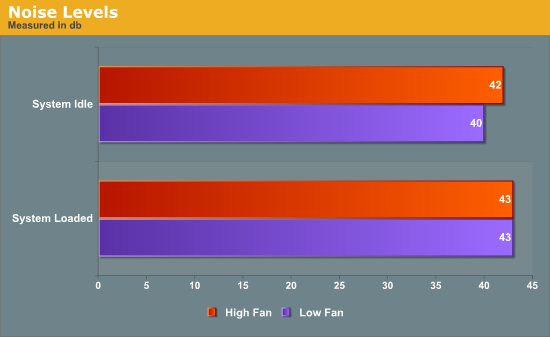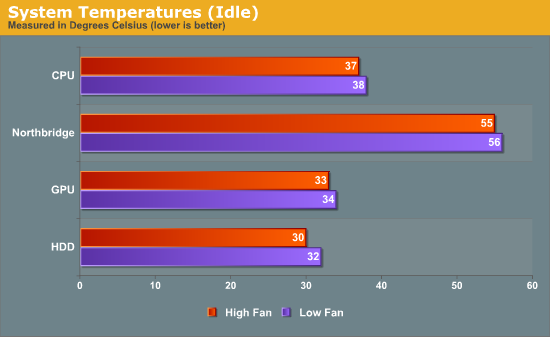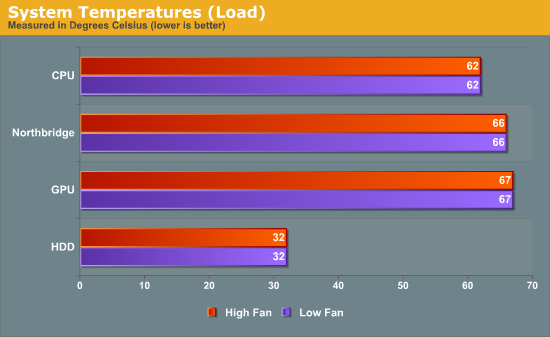Corsair Graphite Series 600T: Cool and Quiet
by Dustin Sklavos on November 26, 2010 2:25 AM EST- Posted in
- Cases/Cooling/PSUs
- Corsair
- 600T
Thermal and Noise Testing
For testing the 600T, I actually used the components from my personal system in the Antec P182. Noise was measured using an Extech SL10 sound meter, while temperatures were measured conventionally using HWMonitor. The test system specs are as follows:
| Test Configuration | |
| CPU | Intel Core i7-930 overclocked to 3.6GHz, undervolted to 1.125v |
| Motherboard | Gigabyte GA-X58A-UD3R rev. 2.0 |
| Graphics Card | XFX Radeon HD 5870 1GB GDDR5 |
| Memory | 3x4GB Corsair Value Select DDR3-1333 |
| Drives |
Memorex DVD+/-RW Combo Drive LG HD-DVD/Blu-ray/DVDRW Combo Drive 2x Western Digital Caviar Blue 640GB (RAID 1) 2x Samsung SpinPoint F3 1TB (RAID 0) Kingston SSDNow 64GB |
| CPU Cooler | Xigmatek Dark Knight S1283 w/ Nexus Silent 120mm Fan |
| Power Supply | Corsair 750HX Modular Power Supply |
My machine isn't particularly noisy to begin with, but it's reasonably powerful and the Core i7-930 can still generate its share of heat. To generate load temperatures and noise, I ran 3DMark06 in a loop with Prime95 in the background and left it running for fifteen minutes at a time. The system was tested with the fan controller at its lowest and highest settings, and the sound meter was positioned one foot away from the tower, on a tripod, pointed directly at the side of the case.

Right away we can tell the fan noise isn't appreciably higher with the controller maxed, but these numbers are also excellent. Subjectively, it has to be nearly dead silent in the apartment for me to be able to hear the tower running, idle or under load. And for those that are curious, the Nexus 120mm fan produces temperatures comparable to the Xigmatek's stock fan at substantially lower RPMs and noise levels.


Once we move into temperature testing, we can see that temperatures are generally pretty solid and that yes, all the other reviews are right: the fan controller and differing fan speeds just don't matter that much. The 200mm fans do seem to move enough air to keep everything fairly cool given the extreme load the system was placed under for stress testing. Since the hard drives are directly behind the front intake, they also remain exceptionally cool. As Martha Stewart would say, it's a good thing.










69 Comments
View All Comments
Dustin Sklavos - Friday, November 26, 2010 - link
Seriously? If the USB 2.0 ports bother you, enjoy your uh...fictional case that doesn't actually exist. The case has a USB 3.0 port, how many 3.0 peripherals do you even have?I, on the other hand, enjoy having that many USB ports handy.
semo - Friday, November 26, 2010 - link
You talk as if USB 3.0 won't become the defacto peripheral standard in the near future. The standard has been out for a while and cases don't see hardware revisions often, so this case will seem outdated once USB 3.0 drives and peripherals become more common.The_Assimilator - Friday, November 26, 2010 - link
How many current motherboard chipsets integrate USB3 controllers? That's right, none. How many upcoming chipsets will integrate USB3? Also none.There's a good reason for this, and it's called Light Peak.
And if you're complaining about PC parts becoming outdated... then you should really stick to consoles. USB ports don't make a case, although I would like to have seen the 60T space the front ones out a bit more to accommodate extra-thick USB flash drives, like Corsair's own Flash Voyager series.
thrust2night - Friday, November 26, 2010 - link
Looks like you've assimilated your ass with your brain.There are motherboards which have more than one onboard USB 3 ports. And if USB ports don't make a case, neither does Light Peak. And since you are obviously not aware that Intel will be releasing motherboards with their own onboard USB 3 controllers in 2012, you made yourself look more like that idiot you are.
USB 3 is here to stay and there is no point in buying a case that offers only one front USB 3 port. If you are right, why would companies even give you a USB 2 port, they could save money and stick with USB 1.1 coz like you said, Light Peak is coming.
semo - Saturday, November 27, 2010 - link
I can't believe USB 3.0 is such a taboo subject on IT sites... it just boggles the mind. We should all be looking forward to it rather and not find merrits with USB 2.0...Anyway, @The_Assimilator I think you should look deeper into Light Peak. It is only an interface and not a bus. You can aggregate USB 3.0 traffic onto Light Peak if you want to but for the immidiate future we need USB 3.0 (spare me the "10 MB/s for my USB stick is enough, I can wait" crap)
LancerVI - Sunday, November 28, 2010 - link
No USB 3.0? No Purchase!The question of USB 3.0 and this cases lack thereof is a valid and good question.
And there are plenty of motherboards with USB 3.0 onboard.
Dear The_Assimilator,
It's better to be thought of as a fool then to open your mouth and remove all doubt.
Lancer VI
thrust2night - Friday, November 26, 2010 - link
So you're saying people should by a case based on the number peripherals they have?And what nerve to contradict your own statement by saying you would enjoy having that many USB ports handy, implying you don't have enough peripherals to use all the USB ports.
He still has a point. If you're paying a high price for a computer case, which you would probably keep for a few years, if not indefinitely, why would you buy one with only one USB 3 port in the front? It's just plain stupid and the worse part is, idiots like you don't even see it.
SandmanWN - Monday, November 29, 2010 - link
Kinda pointless argument. The only thing that can utilize USB3 to its potential is external SSD enclosures. Most people don't even have one of those around. All mouse/keyboards/printers/etc have not use for it.Even the high end user argument is bunk. It will be years before USB3 devices are even common place and by the an enthusiast should have upgraded already.
philosofa - Friday, November 26, 2010 - link
Whilst the USB 2.0 connectors themselves are backwards compatible (i.e. you can fit 2.0 devices into 3.0 ports) the USB 3.0 connectors that connect to the mobo are completely different - afaik there's no way of connecting a USB 3.0 cable conenctor to a USB 2.0 mobo header. As a result the reality of the current situation is that any current case will by necessity have a mix of USB 3.0 and 2.0 connectors, given that a (currently tiny) minority of boards have USB 3.0 headers at all. It's a bit unfair to expect Corsair to exclude the majority of their customers.I suppose some kind of switching system would be possible, but TBH that's probably an excessive expectation on our part- thus I have to applaud the fact that Corsair fitted at least a single USB 3.0 front panel connector; as Dustin says realistically how many USB 3.0 devices will you connect to the front panel (for me it'd just be a USB 3.0 pen drive)?
thrust2night - Friday, November 26, 2010 - link
But on the same note, how many USB 2 peripherals are you connecting to your computer. I would even go as far as to ask if you are actually using the USB 2 ports on the front panel 24x7. Because if you are not, then just having one USB 2 port and the rest as USB 3 would be better.Or, it would have been good to have 2 USB 2.0 and 3 USB 3.0 ports on the front, since the number of motherboards with onboard USB 3 will actually increase making the case future proof. There are some motherboards like AsRock that provide 2 onboard USB 3 ports.